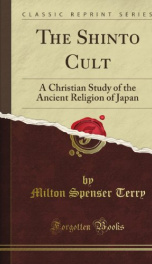the shinto cult a christian study of the ancient religion of japan

THE SHINTO CULT.1. The Country. In taking up the study of a religion which has never extended beyond the limits of an easily defined_terrilQry, we may appropriately first of all take a hasty glance at the geographical outlines of the system we call Shinto, the primitive faith of the people of Japan. To appreciate the geographical position of Japan, one needs to have before him a map of the world. He may then see at a glance how remarkably the three thousand islands of that Empire stretch for some twentyifive hundred miles along _the coast of Asia, from Kamchatka on the north to the island of .Formosa on the south, which island is crossed by^the tropic of Cancer. It may be called the longest and the narrowest counjvy in-tlux-w^rl It looks like an immense sea-serpent, with its northern tail twist-Table of Contents CONTENTS; 1 The Country 7; 2 Is Shinto a Religion? 10; 3 Origin and Relative Age of the; People 12; 4 Meaning of the Term Shinto 14; 5 Sources of Information 15; 6 Japanese Cosmogony and Mythol-; ogy 19; 7 The Japanese a Self-centered Peo-; ple 29; 8 Essence of the Shinto Cult 30; 9 The Great Sanctuaries 31; 10 Five Noteworthy Objects Con-; nected with the Worship 34; 11 The Ancestor Worship 37; 12 Elements of Animism 41; 13 The Domestic Cult 43; 14 The Communal Cult 45; 15 The National Cult 49; 6 CONTENTS; 16 The Harvest Service 52; 17 The Great Purification 54; 18 Other Ritual Services CO; 19 Influence of China on Japanese; Thought G3; 20 Influence of Buddhism G4; 21 Revival of Pure Shinto 68; 22 Esoteric Shinto 70; 23 Mingling of Shinto, Confucianism,; and Buddhism 71; 24 Roman Catholicism in Japan 73; 25 Alleged Present Religious Indif-; ference 74; 26 Concluding Observations 78About the Publisher Forgotten Books is a publisher of historical writings, such as: Philosophy, Classics, Science, Religion, History, Folklore and Mythol
Info about the book
Author:
Series:
Unknown
ISBN:
0891090827
Rating:
4/5 (2)Your rating:
0/5
Languge:
English
Users who have this book
Users who want this book
What readers are saying
What do you think? Write your own comment on this book!
write a commentif you like the shinto cult a christian study of the ancient religion of japan try:
Other books by this author
Do you want to exchange books? It’s EASY!
Get registered and find other users who want to give their favourite books to good hands!


